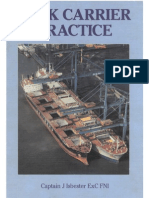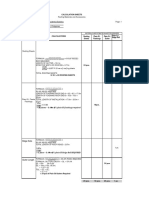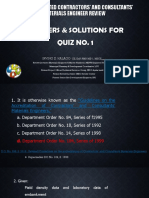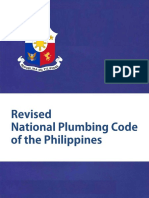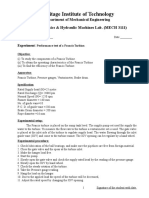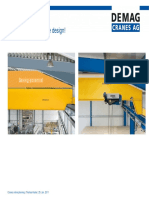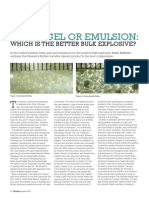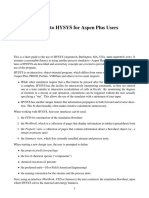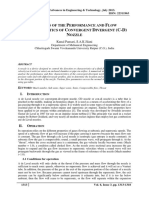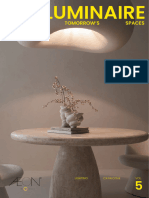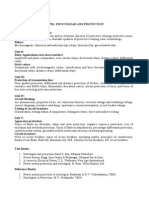Hempadur Mastic 45881-12170
Hempadur Mastic 45881-12170
Uploaded by
Bang OchimCopyright:
Available Formats
Hempadur Mastic 45881-12170
Hempadur Mastic 45881-12170
Uploaded by
Bang OchimOriginal Description:
Copyright
Available Formats
Share this document
Did you find this document useful?
Is this content inappropriate?
Copyright:
Available Formats
Hempadur Mastic 45881-12170
Hempadur Mastic 45881-12170
Uploaded by
Bang OchimCopyright:
Available Formats
Product Data
HEMPADUR MASTIC 45881
High temperatures 45881: BASE 45889: CURING AGENT 95881
Description: HEMPADUR MASTIC 45881 is a two-component polyamide adduct cured, high solids, high build epoxy
paint. It forms a hard and tough coating, has good wetting properties.
Recommended use: As a selfprimed, surface tolerant paint system or as an intermediate or finishing coat in heavy duty
paint systems where low VOC and high film build are required.
For immersed areas HEMPADUR MASTIC 45881 is only recommended for minor repairs.
Can be specified where extended recoating properties for polyurethane topcoats are requested
(typically travel coating). May be used directly on cured zinc silicate (GALVOSIL products) or spray-
metallized surfaces to minimize popping.
Service temperature: Maximum, dry exposure only: 120°C/248°F
Certificates/Approvals: In accordance with Aramco’s specification APCS 1, APCS 12, APCS 26 and 26T.
Tested for non-contamination of grain cargo at the Newcastle Occupational Health & Hygiene, Great
Britain.
Approved as a low flame spread material when used as part of a predefined paint system. Please refer
to “Declaration of Conformity” on www.Hempel.com for further details.
Complies with EU Directive 2004/42/EC: subcategory j.
Availability: Part of Group Assortment. Local availability subject to confirmation.
PHYSICAL CONSTANTS:
Shade nos/Colours: 12170* / Grey. (see REMARKS overleaf)
Finish: Semi-gloss
Volume solids, %: 80 ± 1
Theoretical spreading rate: 6.4 m2/l [256.6 sq.ft./US gallon] - 125 micron/5 mils
Flash point: 35 °C [95 °F]
Specific gravity: 1.5 kg/litre [12.1 lbs/US gallon]
Surface-dry: 4.5 hour(s) 20°C/68°F
Through-dry: 6.5 hour(s) 20°C/68°F
Fully cured: 5 day(s) 30°C/86°F
VOC content: 218 g/l [1.8 lbs/US gallon]
Shelf life: 3 years for BASE and 3 years (25°C/77°F) for CURING AGENT from time of production.
- *Wide range of colours available via Hempel's MULTI-TINT system.
- The physical constants stated are nominal data according to the HEMPEL Group's approved formulas.
APPLICATION DETAILS:
Version, mixed product: 45881
Mixing ratio: BASE 45889: CURING AGENT 95881
3 : 1 by volume
Application method: Airless spray / Brush
Thinner (max.vol.): < 5% HEMPEL'S THINNER 08450, depending on purpose (see REMARKS overleaf)
Pot life (Airless spray): 1.5 hour(s) 30°C/86°F
Pot life (Brush): 2 hour(s) 30°C/86°F
Nozzle orifice: 0.017 - 0.023 " According to separate APPLICATION INSTRUCTIONS
Nozzle pressure: 250 bar [3625 psi]
Cleaning of tools: HEMPEL'S TOOL CLEANER 99610
Indicated film thickness, dry: 125 micron [5 mils] see REMARKS overleaf
Indicated film thickness, wet: 150 micron [6 mils]
Overcoat interval, min: see REMARKS overleaf
Overcoat interval, max: see REMARKS overleaf
-
Safety: Handle with care. Before and during use, observe all safety labels on packaging and paint containers,
consult HEMPEL Safety Data Sheets and follow all local or national safety regulations.
-
-
-
-
-
-
Date of issue: December 2015 Page: 1/2
Product Data
HEMPADUR MASTIC 45881
SURFACE PREPARATION: New steel: Abrasive blasting to minimum Sa 2½ (ISO 8501-1:2007) with a surface profile
corresponding to Rugotest No. 3, N9a to N10, preferably BN9a to BN10, Keane-Tator Comparator, 2.0
G/S or ISO Comparator, Medium (G).
Zinc silicate painted or spray-metallized surfaces: Remove oil and grease, etc. with suitable
detergent. Remove salt and other contaminants by (high pressure) fresh water cleaning. Zinc salts
(white rust) must be removed by high pressure hosing combined with rubbing with a stiff nylon brush if
necessary. It is recommended to recoat spray-metallized surfaces as soon as possible to avoid
possible contamination.
Concrete: Remove slip agent and other possible contaminants by emulsion washing followed by high
pressure hosing with fresh water. Remove scum layer and loose matter to a hard, rough and uniform
surface, preferably by abrasive blasting, possibly by other mechanical treatment or acid etching. Seal
surface with suitable sealer, as per relevant painting specification.
Repair and maintenance: Remove oil and grease etc. thoroughly with suitable detergent. Remove
salts and other contaminants by high pressure fresh water cleaning. Clean damaged areas thoroughly
by power tool cleaning to minimum St 2 (spot-repairs) or by abrasive blasting to min. Sa 2, preferably to
Sa 2½ (ISO 8501-1:1988). Improved surface preparation will improve the performance of the product.
As an alternative to dry cleaning, water jetting to sound, well adhering coat and/or to steel. Intact coat
must appear with roughened surface after the water jetting. By water jetting to steel, cleanliness shall
be: Wa 2 -Wa 2½ (atmospheric exposure) / minimum Wa 2½ (immersion) (ISO 8501-4:2006). Feather
edges to sound and intact areas. Dust off residues. Touch up to full film thickness. On pit-corroded
surfaces, excessive amounts of salt residues may call for high pressure water jetting, wet abrasive
blasting or, alternatively, dry abrasive blasting, high pressure fresh water hosting, drying, and finally dry
abrasive blasting again.
APPLICATION CONDITIONS: Apply only on a dry and clean surface with a temperature above the dew point to avoid condensation.
Use only where application and curing can proceed at temperatures above: 15°C/59°F.
The temperature of paint itself should be 15°C/59°F or above. In confined spaces provide adequate
ventilation during application and drying.
PRECEDING COAT: None, or as per specification.
SUBSEQUENT COAT: None, or as per specification.
REMARKS:
VOC - EU Directive 2004/42/EC:
Not available.
Product As supplied 5 vol. % thinning Limit phase II, 2010
4588112170 218 g/l 250 g/l 500 g/l
For VOC of other shades, please refer to Safety Data Sheet.
Weathering/service temperatures: The natural tendency of epoxy coatings to chalk in outdoor exposure and to become more sensitive to
mechanical damage and chemical exposure at elevated temperatures is also reflected in this product.
Application(s): Application onto zinc silicate or spray-metallized surfaces (thinning): It is recommended to apply the
paint by using a "mist-coat" procedure provided the paint temperature is approximately above:
20°C/68°F. A thin, undiluted coat is applied (the mist coat) and after a few minutes, a second coat is
applied in the full specified film thickness. If the paint temperature is below: 20°C/68°F, thinning (max
15%) may be required.
Film thicknesses/thinning: May be specified in another film thickness than indicated depending on purpose and area of use. This
will alter spreading rate and may influence drying time and overcoating interval. Normal range dry is:
100-200 micron/4-8 mils. May be specified in lower film thickness for which purpose additional thinning
is required, please see separate APPLICATION INSTRUCTIONS. Avoid application of excessive
film thicknesses.
Shades: The product is also available in a Micaceous Iron Oxide (MIO) pigmented shade (Shade no. 12430 –
reddish grey ) and in aluminium pigmented shades (Shade nos. 19870 - dark alu and 19000 - light alu).
Overcoating: Overcoating intervals related to later conditions of exposure: If the maximum overcoating interval is
exceeded, roughening of the surface is necessary to ensure intercoat adhesion.
Before overcoating after exposure in contaminated environment, clean the surface thoroughly with high
pressure fresh water hosing and allow drying.
A specification supersedes any guideline overcoat intervals indicated in the table.
Environment Atmospheric, medium
Surface temperature: 20°C (68°F) 30°C (86°F) 40°C (104°F)
Min Max Min Max Min Max
HEMPADUR 7h Ext. 6h Ext. 4h Ext.
HEMPATEX 5h 16 h 4h 12 h 3h 8h
HEMPATHANE 7h Ext. 6h Ext. 4h Ext.
Environment Immersion
HEMPADUR 12 h 30 d 10 h 23 d 7h 15 d
NR = Not Recommended, Ext. = Extended, m = minute(s), h = hour(s), d = day(s)
Note: HEMPADUR MASTIC 45881 For professional use only.
ISSUED BY: HEMPEL A/S 4588112170
X Move PDS Disclaimer to Second page
Date of issue: December 2015 Page: 2/2
Product Data
HEMPADUR MASTIC 45881
This Product Data Sheet supersedes those previously issued.
For explanations, definitions and scope, see “Explanatory Notes” available on www.hempel.com. Data, specifications, directions and recommendations given in this data sheet
represent only test results or experience obtained under controlled or specially defined circumstances. Their accuracy, completeness or appropriateness under the actual conditions
of any intended use of the Products herein must be determined exclusively by the Buyer and/or User.
The Products are supplied and all technical assistance is given subject to HEMPEL's GENERAL CONDITIONS OF SALES, DELIVERY AND SERVICE, unless otherwise expressly agreed
in writing. The Manufacturer and Seller disclaim, and Buyer and/or User waive all claims involving, any liability, including but not limited to negligence, except as expressed in said
GENERAL CONDITIONS for all results, injury or direct or consequential losses or damages arising from the use of the Products as recommended above, on the overleaf or otherwise.
Product data are subject to change without notice and become void five years from the date of issue.
Date of issue: December 2015 Page: 3/2
You might also like
- Bulk Carrier PracticeDocument6 pagesBulk Carrier PracticeNezupher Shammoon88% (8)
- Foton CatalougeDocument9 pagesFoton CatalougeGomez RonieNo ratings yet
- Calculation SheetDocument6 pagesCalculation Sheetalaska youngNo ratings yet
- Fundamentals of Thermodynamics Appendix BDocument50 pagesFundamentals of Thermodynamics Appendix BGwenShepherdNo ratings yet
- Daconil 720 SC: Safety Data SheetDocument9 pagesDaconil 720 SC: Safety Data SheetAngelicaNo ratings yet
- Linear Programming and Applications: (Vi) Reservoir Operation and Reservoir Sizing Using LPDocument22 pagesLinear Programming and Applications: (Vi) Reservoir Operation and Reservoir Sizing Using LPRas MekonnenNo ratings yet
- ENGENVI Quiz2 Reviewer 1Document8 pagesENGENVI Quiz2 Reviewer 1Raine MangahasNo ratings yet
- WWWWDocument52 pagesWWWWBang OchimNo ratings yet
- 20316344D1198 LDocument56 pages20316344D1198 LBang Ochim0% (1)
- Operating Instruction Gear Box AFM04,05,06Document20 pagesOperating Instruction Gear Box AFM04,05,06Bang Ochim100% (1)
- 7-4 Grading and Maintenance of Untreated SurfaceDocument10 pages7-4 Grading and Maintenance of Untreated SurfaceJobay Guden0% (1)
- C. Ra 6969 - Engr. Czes BongcoDocument87 pagesC. Ra 6969 - Engr. Czes Bongcorandell vasquezNo ratings yet
- Estimating Missing Precipitation Data 1Document25 pagesEstimating Missing Precipitation Data 1pjNo ratings yet
- Lab Report Air ParticleDocument11 pagesLab Report Air ParticleSalmah AbasNo ratings yet
- Particleboard - Chapter 1Document6 pagesParticleboard - Chapter 1Jay-R NuestroNo ratings yet
- PSYCHROMETRIC - Basics of Drying PDFDocument79 pagesPSYCHROMETRIC - Basics of Drying PDFwindie annisaNo ratings yet
- Philippine Isohyetal Map (1986-2015) Month of September: LegendDocument1 pagePhilippine Isohyetal Map (1986-2015) Month of September: LegendDWIGHT GERONIMONo ratings yet
- Sample Problems Dec 05 2022Document30 pagesSample Problems Dec 05 2022JoYhCo OrPaPr100% (1)
- Ginger Guice Extracting MachineDocument33 pagesGinger Guice Extracting MachineSanman SawantNo ratings yet
- LatihanDocument5 pagesLatihanAyu Mustika100% (2)
- 4 One Way SlabDocument22 pages4 One Way SlabCandice Aberin Mag-alasinNo ratings yet
- Overview+Soil Quiz 1Document241 pagesOverview+Soil Quiz 1Elmer Cabulisan JrNo ratings yet
- Building System Design Plate 3-Ground Floor PLanDocument1 pageBuilding System Design Plate 3-Ground Floor PLanLester de GuzmanNo ratings yet
- Drainage Design HAND NoteDocument18 pagesDrainage Design HAND NoteShoayful islamNo ratings yet
- Building Services-LiftDocument29 pagesBuilding Services-Liftshubham sharmaNo ratings yet
- Annex 1 - 2 Water Body ClassificationsDocument2 pagesAnnex 1 - 2 Water Body ClassificationsADZRIN JUSALINo ratings yet
- BUWAGGAGADocument42 pagesBUWAGGAGAIvan Mikhail ReyesNo ratings yet
- 123 - Concrete CoverDocument2 pages123 - Concrete CoverrealchicNo ratings yet
- Plastic Limit ReportDocument12 pagesPlastic Limit ReportEiyra NadiaNo ratings yet
- Allowable Ampacities of Insulated Conductors RatedDocument1 pageAllowable Ampacities of Insulated Conductors RatedDan C. LabagnoyNo ratings yet
- Chapter I: Engineer'S Report: 3.I Water Supply Route Plan Route 1 Route 2 Route 3 Route 4 Main RouteDocument22 pagesChapter I: Engineer'S Report: 3.I Water Supply Route Plan Route 1 Route 2 Route 3 Route 4 Main Routenash silonganNo ratings yet
- Others Processes Techhniques Strategies AnsweredDocument6 pagesOthers Processes Techhniques Strategies AnsweredAcmidah DilnaNo ratings yet
- Vivas Basabeiii Abp32d Rice and Other Crop Processing MachineryDocument69 pagesVivas Basabeiii Abp32d Rice and Other Crop Processing MachineryArman RiveraNo ratings yet
- Automatic Drainage Cleaning System IJERTV8IS050077Document2 pagesAutomatic Drainage Cleaning System IJERTV8IS050077Kate VentilacionNo ratings yet
- History of BSTPDocument1 pageHistory of BSTPClaudine Cabico ValdezNo ratings yet
- PBDLOT76GAA2022Document83 pagesPBDLOT76GAA2022Reynante GungonNo ratings yet
- Forces On Curved Surfaces PDFDocument9 pagesForces On Curved Surfaces PDFSunny MaitangNo ratings yet
- Chapter 5Document59 pagesChapter 5Amirul ZolkhairiNo ratings yet
- DrivetrainDocument3 pagesDrivetrainhardcore cylinderNo ratings yet
- Piggery Drawing and AnalysisDocument5 pagesPiggery Drawing and AnalysisEr Bukul Chandra BaroNo ratings yet
- Selection Among AlternativesDocument24 pagesSelection Among AlternativesDave DespabiladerasNo ratings yet
- War 2103 PrecipitationDocument52 pagesWar 2103 PrecipitationEgana IsaacNo ratings yet
- Plumbing Code of The Philippines ChapterDocument5 pagesPlumbing Code of The Philippines ChapterNaga AlabNo ratings yet
- Concept Paper - Macapuno Grating Machine PDFDocument3 pagesConcept Paper - Macapuno Grating Machine PDFDom BolNo ratings yet
- Calculation For Detention-Tank ProvisionDocument2 pagesCalculation For Detention-Tank ProvisionluishorquiaNo ratings yet
- Francis Turbine ManualDocument4 pagesFrancis Turbine ManualAbhijeet MishraNo ratings yet
- Hydraulics Reviewer by Ricardo Asin PDFDocument122 pagesHydraulics Reviewer by Ricardo Asin PDFEmmanuel John MillaresNo ratings yet
- Problems 4 ChopDocument9 pagesProblems 4 ChopAnandlal RNo ratings yet
- Drawing1-Model1 FOR THE REPORTDocument1 pageDrawing1-Model1 FOR THE REPORTkundayi shavaNo ratings yet
- Pipe Schedule:: Engineer: Proejct Title / Location: OwnerDocument1 pagePipe Schedule:: Engineer: Proejct Title / Location: OwnerJap IbeNo ratings yet
- NPCP Chapter 4Document3 pagesNPCP Chapter 4Ryan CaduyacNo ratings yet
- NATIONAL PLUMBING CODE OF THE PHILIPPINES SummaryDocument4 pagesNATIONAL PLUMBING CODE OF THE PHILIPPINES SummaryElyssa GamboaNo ratings yet
- Dao 35Document9 pagesDao 35phiongskiNo ratings yet
- Assignment 1Document1 pageAssignment 1Robin ParmarNo ratings yet
- Planning, Analysis & Design of A Four-Stored Residential Bulding by Using Staad ProDocument2 pagesPlanning, Analysis & Design of A Four-Stored Residential Bulding by Using Staad ProDharma banothuNo ratings yet
- Solution By: Deepak GuptaDocument86 pagesSolution By: Deepak GuptaVinod yadavNo ratings yet
- UGC Company Profile For Accreditation 11.15.21Document54 pagesUGC Company Profile For Accreditation 11.15.21AJ PAJENo ratings yet
- Wastewater Characterization: Agroindustrial Technology Department University of BrawijayaDocument39 pagesWastewater Characterization: Agroindustrial Technology Department University of Brawijayadevilturn70100% (1)
- Greaves 10 To 500 Kva Genset ECatalogueDocument2 pagesGreaves 10 To 500 Kva Genset ECatalogueArpit Verma100% (1)
- LECTURE 1 Basic Principles of The Plumbing CodeDocument32 pagesLECTURE 1 Basic Principles of The Plumbing Codepepito manalotoNo ratings yet
- Complete Download of Structural Analysis 5th Edition Aslam Kassimali Solutions Manual Full Chapters in PDFDocument51 pagesComplete Download of Structural Analysis 5th Edition Aslam Kassimali Solutions Manual Full Chapters in PDFgombaromgbwa81100% (2)
- CE142P-2 / E01 Engr. Edward Monjardin 01-09-21 01-12-21: Jingona, Fatimah Rahima TDocument6 pagesCE142P-2 / E01 Engr. Edward Monjardin 01-09-21 01-12-21: Jingona, Fatimah Rahima TFatimah Rahima Jingona100% (1)
- APCS-26T HempelDocument5 pagesAPCS-26T HempelarjunmohananNo ratings yet
- Pds Hempadur Mastic 45880 En-GbDocument3 pagesPds Hempadur Mastic 45880 En-GbQA QCNo ratings yet
- GADocument72 pagesGABang OchimNo ratings yet
- BMG Brochure For Wire Rope HoistDocument4 pagesBMG Brochure For Wire Rope HoistBang OchimNo ratings yet
- Demag - DMRDocument20 pagesDemag - DMRBang OchimNo ratings yet
- 20283644D0698 LDocument8 pages20283644D0698 LBang OchimNo ratings yet
- Din 15018 H2 B2 D-JT 360 1000 KG - 2M / M5 - Manual 58,3 Knm/39 KN 380 V 3 50 HZ 24 V 1258 KG Ral 1007 Ral 1007Document1 pageDin 15018 H2 B2 D-JT 360 1000 KG - 2M / M5 - Manual 58,3 Knm/39 KN 380 V 3 50 HZ 24 V 1258 KG Ral 1007 Ral 1007Bang Ochim100% (1)
- Clear Span - TypeDocument1 pageClear Span - TypeBang OchimNo ratings yet
- D 0100Document20 pagesD 0100Bang OchimNo ratings yet
- Trailing Power Supply Lines: KBK 0, KBK 25, KBK 100Document24 pagesTrailing Power Supply Lines: KBK 0, KBK 25, KBK 100Bang OchimNo ratings yet
- Demag Chain Hoists: Dkun 1 - Dkun 2 - Dkun 5 - Dkun 10 - Dkun 16 - Dkun 20 - DKM 1 - DKM 2Document84 pagesDemag Chain Hoists: Dkun 1 - Dkun 2 - Dkun 5 - Dkun 10 - Dkun 16 - Dkun 20 - DKM 1 - DKM 2Bang Ochim100% (1)
- Safety Rules For Electric Motors: 0398 EN 201 384 84 720 IS 910Document2 pagesSafety Rules For Electric Motors: 0398 EN 201 384 84 720 IS 910Bang OchimNo ratings yet
- Assembly Instructions: Limit Switches DKUN 1Document24 pagesAssembly Instructions: Limit Switches DKUN 1Bang OchimNo ratings yet
- 20291144D1197 LDocument12 pages20291144D1197 LBang OchimNo ratings yet
- D 0498Document28 pagesD 0498Bang OchimNo ratings yet
- You Have The Shape - We Have The Right Crane Design!: Saving PotentialDocument4 pagesYou Have The Shape - We Have The Right Crane Design!: Saving PotentialBang OchimNo ratings yet
- Component Parts: DZW Position Measuring SystemDocument12 pagesComponent Parts: DZW Position Measuring SystemBang OchimNo ratings yet
- 20334144D0300 LDocument104 pages20334144D0300 LBang OchimNo ratings yet
- Crane Components - : Quality in DetailDocument12 pagesCrane Components - : Quality in DetailBang OchimNo ratings yet
- Catalog NoDocument68 pagesCatalog NoBang OchimNo ratings yet
- Primeflex General CatalogueDocument4 pagesPrimeflex General CatalogueBang OchimNo ratings yet
- Colour Card RalDocument16 pagesColour Card RalBang OchimNo ratings yet
- Specifications: Main Functions Equipment SpecificationsDocument1 pageSpecifications: Main Functions Equipment SpecificationsBang OchimNo ratings yet
- Sambungan LasDocument12 pagesSambungan LasBang OchimNo ratings yet
- Watergel or Emulsions Which Is The Better Bulk Explosive?Document4 pagesWatergel or Emulsions Which Is The Better Bulk Explosive?Brent BuffhamNo ratings yet
- AttachmentDocument488 pagesAttachmentHeri YantoNo ratings yet
- CAJ9510ZDocument1 pageCAJ9510Zأبو زينب المهندسNo ratings yet
- Design of ShaftsDocument37 pagesDesign of ShaftsJithin KNo ratings yet
- MAIN DIFFERENCES Between TS55 and TMS Rev.2 May2018Document6 pagesMAIN DIFFERENCES Between TS55 and TMS Rev.2 May2018younes abedNo ratings yet
- Confirm Delegate List - Final (4th July)Document38 pagesConfirm Delegate List - Final (4th July)Abirami PriyadharsiniNo ratings yet
- Drainline BrochureDocument27 pagesDrainline BrochureBert EngNo ratings yet
- 12 Adc PDFDocument17 pages12 Adc PDFYonathan MoraNo ratings yet
- Hysys For Aspen Plus Users PDFDocument11 pagesHysys For Aspen Plus Users PDFKarim KholeifNo ratings yet
- Hyundai Welding Handbook (12th) - AppendixDocument68 pagesHyundai Welding Handbook (12th) - AppendixNguyen Anh TuanNo ratings yet
- 2020 - 11 - 12 Alcad Slim Battery Solution LaunchDocument2 pages2020 - 11 - 12 Alcad Slim Battery Solution LaunchabdelhalimNo ratings yet
- B737-Ng Tools List: NO. Description P/N S/N Product Number Location Id No. Type QTY ConditionDocument2 pagesB737-Ng Tools List: NO. Description P/N S/N Product Number Location Id No. Type QTY Conditionyousefallam2No ratings yet
- CV KasongoDocument14 pagesCV KasongoDickson MatikuNo ratings yet
- Pg032 - o Power LV (N) YyryDocument1 pagePg032 - o Power LV (N) YyryDolyNo ratings yet
- Nozzle CFD AnalysisDocument6 pagesNozzle CFD AnalysisPett PeeveNo ratings yet
- Effect Pedal GroundingDocument10 pagesEffect Pedal GroundingFooNo ratings yet
- SOL LuminaireDocument59 pagesSOL Luminairekpx5r82scbNo ratings yet
- ROLLAND ZAT540eDocument17 pagesROLLAND ZAT540egesssmNo ratings yet
- SDS - Chemrock 913Document1 pageSDS - Chemrock 913mangengueyNo ratings yet
- Bateria CCB 1Document23 pagesBateria CCB 1david henriquezNo ratings yet
- Switchgear and Protection by Sunil S RaoDocument8 pagesSwitchgear and Protection by Sunil S RaoAninditaRoy0% (4)
- Viper 12ADocument21 pagesViper 12Aahmed hussainNo ratings yet
- Attachment 1 - SOW For Port-O-CabinsDocument8 pagesAttachment 1 - SOW For Port-O-CabinsZafar BakhshNo ratings yet
- C.B.S.E Study Material 2 (Unit-1)Document71 pagesC.B.S.E Study Material 2 (Unit-1)vikramkhatri4100% (2)
- Data Entry Instructions Terms and ConditionsDocument2 pagesData Entry Instructions Terms and ConditionsselvasrijaNo ratings yet
- C5 Install Manual Rel UpdatedDocument29 pagesC5 Install Manual Rel UpdatedMampi BaidyaNo ratings yet
- USN 1 8 E E 5 4: Electrical Machine DesignDocument3 pagesUSN 1 8 E E 5 4: Electrical Machine Design1DA19EE004 AMBUJ KUMAR MISHRANo ratings yet
- Ethylene Oxide Sterilization PDFDocument2 pagesEthylene Oxide Sterilization PDFRobertNo ratings yet
- 3512 B Main Generator Parts Manual PDF Vehicle Technology Manufactured GoodsDocument1 page3512 B Main Generator Parts Manual PDF Vehicle Technology Manufactured GoodsJamalNo ratings yet
